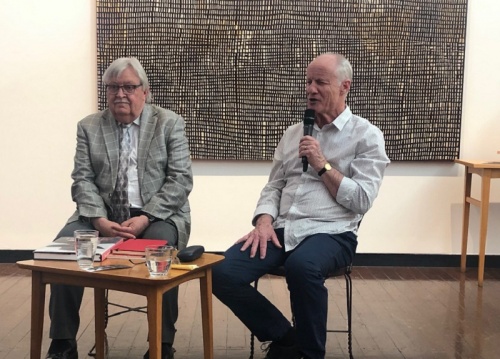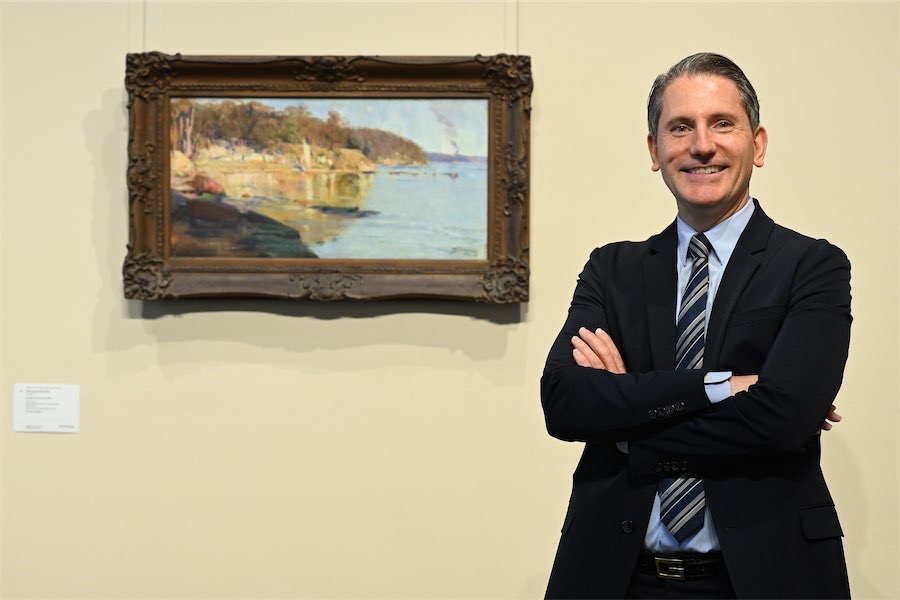A NEW biography of an important Western Desert Aboriginal artist had its Canberra launch this week at the ANU Drill Hall Gallery.
“The Master from Marnpi”, by scholar Alec O’Halloran, looks at the life and work of Mick Namarari Tjapaltjarri, a Pintupi man from the Western Desert.
Ashy Pintupi was a boy from the desert who would one day receive the nation’s highest indigenous art accolade, the Red Ochre award, Namarari is shown as a child, survivor, stockman, traveller, artist, family leader, cultural advocate and community member, through his life in Australia’s desert settlements.
O’Halloran took advantage of his presence in Canberra for the ANU’s conference, “Re-framing Indigenous Biography”, to converse with Drill Hall director Terence Maloon.
Maloon noted that the university’s vice chancellor, Brian Schmidt, always says universities are places where conversations take place.
That, he said, was exactly what was happening in this case, as he stood in the midst of the magnificent acquisitions under the Craig Edwards’ gift of indigenous art—but most of that work had been painted by women.
But whether by men or women, he observed, “you don’t start out without wisdom“.
Maloon introduced O’Halloran as an author and doctoral graduate of the university who had a strong history of engaging with remote communities.
For his part, O’Halloran paid tribute to the great anthropologists and economists who had studied indigenous communities for having “walked together with the people”.
He too had found that “you always walk in people’s traces”.
His exploration of remote places and people had been, in Maloon’s view, “an adventure”, but to O’Halloran himself, the desert had presented a “tabula rasa” since he’d had no previous acquaintance with remote societies. Although he had pondered his own ignorance of what he called “people’s notion of country“.

“I was something of a beginner,” he told those present at the talk as he described his introduction to the Pintupi community, about 500 kilometres west of Alice Springs, where he had learnt of emotional connections to the land, cultural inheritance, physical connections and dreaming stories, especially those of the kangaroo.
As he talked to the master about “his country” and his “tjukurpa” of views on life and society, he learnt that Namarari had painted other places but it didn’t claim them. Born in the 1920s, he had lived elsewhere, but in the 1980s returned to his own country.
O’Halloran made his base Kintore, the biggest settlement in the region, quickly finding a pragmatic view of white visitors among the local population, who knew that white friends usually had access to petrol and money.
“I think he [Namarari] wants to take me on a trip,” it dawned on O’Halloran and he went on that trip.
“Mick comes out of a timeless condition where people are hunter-gatherers with no acquaintance with white people,” he said.
But it was important to understand, O’Halloran said, that remote community Aboriginal people have “a proud and measured adaptation to modernity”.
“Over the years they’ve had so many people talking to them asking those questions about firsts — like when did you first see white people, clothes, horses, flowers? — that they’ve become very skilled at telling those stories of cross-cultural interaction,” he said.
“Mick didn’t say much,” he said, but he was grounded in place, he wanted to pass on stories to his children.
“He didn’t speak about art or painting, but he knew what he was doing.”
Indeed, O’Halloran could recall only two phrases that throw light on his view of art. One was his wife’s assertion that “he was showing me to be an artist”, and the other from the master himself, who said, “I paint real slow”.
“The Master from Marnpi”, $80, orders to book@alecohalloran.com
Meet the author’ events: Woden Harry Hartog bookstore, Westfield Plaza, 12pm-1pm, Saturday, November 1; and the Drill Hall Gallery, 1pm-2pm, also tomorrow.
Who can be trusted?
In a world of spin and confusion, there’s never been a more important time to support independent journalism in Canberra.
If you trust our work online and want to enforce the power of independent voices, I invite you to make a small contribution.
Every dollar of support is invested back into our journalism to help keep citynews.com.au strong and free.
Thank you,
Ian Meikle, editor




Leave a Reply